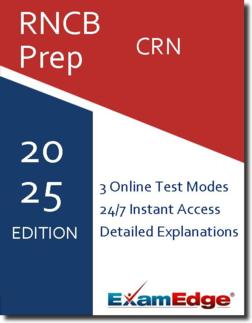RNCB CRN (CRN) Practice Tests & Test Prep by Exam Edge - Topics
Based on 37 Reviews
- Real Exam Simulation: Timed questions and matching content build comfort for your RNCB CRN test day.
- Instant, 24/7 Access: Web-based RNCB Certified Radiology Nurse practice exams with no software needed.
- Clear Explanations: Step-by-step answers and explanations for your RNCB exam to strengthen understanding.
- Boosted Confidence: Reduces anxiety and improves test-taking skills to ace your RNCB Certified Radiology Nurse (CRN).

Understanding the exact breakdown of the RNCB Certified Radiology Nurse test will help you know what to expect and how to most effectively prepare. The RNCB Certified Radiology Nurse has 150 multiple-choice questions The exam will be broken down into the sections below:
| RNCB Certified Radiology Nurse Exam Blueprint | ||
|---|---|---|
| Domain Name | % | Number of Questions |
| Assess patient and plan care | 25% | 38 |
| Administer, monitor, and evaluate therapeutic interventions | 25% | 38 |
| Teach patient and family/Provide a supportive environment | 17% | 26 |
| Provide a safe environment/Manage emergency situations | 25% | 38 |
| Participate in QA/CQI, interdisciplinary activities, and professional practice activities | 8% | 12 |


